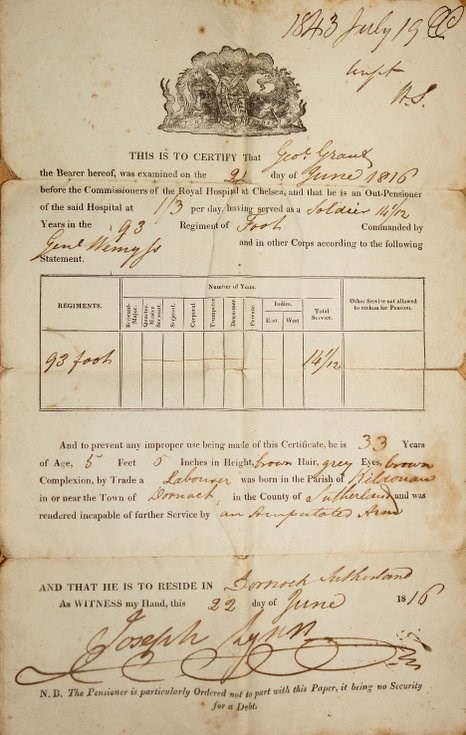
Royal Hospital Chelsea out-patient papers George Grant 93 Foot
Copies of a one page certificate and cover sheet and instructions provided to George Grant following his examination on 21 June 1816 "before the Commissioners of the Royal Hospital Chelsea and that he is an Out-Pensioner of the said Hospital at 1/3 per day having served as a Soldier 14 1/2 years in the 93 Regiment of Foot Commanded by Genl Wemyss " The certificate records he was 33 years of age, 5 feet 5 inches in height with brown hair, grey eyes and brown complexion, by trade a labourer, born in the Parish of Kildonan in or near the Town of Dornoch and was rendered incapable of further service by an amputated arm and "that he is to reside in Dornoch, Sutherland"
It is probable that George Grant received his wound in the Battle of Orleans in 1815 and may well have been amongst those who mustered at Strathnaver in 1800 when the regiment was reformed and thereafter sent on active service to Ireland, South Africa and America. A short history of the 93rd provides the following details:
The 93rd Regiment was raised three times before it became the Sutherland Highlanders.
The 1st Sutherland Fencibles were raised in Scotland from the area of Sutherland and Caithness in 1759 and disbanded in 1763 by Lord Reay.
In 1779: 2nd Sutherland Fencibles raised by Elizabeth, Countess of Sutherland (in practice by Lt. Col. William Wemyss of Wemyss).
1793: 3rd Sutherland Fencibles raised by Wemyss. Served in 1798 Irish Rebellion. Disbanded April 1799 at Fort George.
On disbanding in 1799 the new 93rd Regiment was recruited from the recently disbanded Sutherland Fencibles by their old colonel William Wemyss, at this time a Major General in the British Army, on behalf of his cousin Elizabeth, Countess of Sutherland. Wemyss had the remaining volunteers from all over Sutherland lined up by Parish and selected those he thought most suitable and issued each of these a pinch of snuff, a dram of whisky and their bounty money. When the regiment first mustered, in Strathnaver in August 1800, not a single man selected by Wemyss failed to report. There is a cairn at Skail, in Strathnaver, marking the spot where this muster took place.
In October 1800 the 93rd Regiment of Foot was formally gazetted into the Army and in February 1803 was despatched to Dublin to assist in quelling insurrection.
In August 1805 the Regiment sailed for Cape of Good Hope, South Africa and arrived on 4 January 1806 at Table Bay. It formed the Highland Brigade with the 71st & 72nd Regiments with the objective of the recapture Cape Colony from the Dutch and this was accomplished on 18 January when the Cape Colony surrendered. The 93rd moved into garrison at Cape Castle and remained in the Cape 1806–1814.
In April 1814 the Regiment embarked for Britain arriving at Plymouth on 15 August 1814 and one month later on 17 September 1814 embarked for the American campaign. The General Officer Commanding, Plymouth, ordered the 93rd to wear trews and hummel bonnets for the campaign.
On 23 December 1814 the 93rd landed near New Orleans, arriving in time to help turn the flank of an American surprise night attack. The Regiment then took part in the Battle of New Orleans from 28 December 1814 until the final British assault on 8 January 1815 when 93rd suffered heavy losses (300- 550 killed, wounded and prisoner).
On 18–30 January the British withdrew downriver to embark on ships. On 11 February the British captured Fort Bowyer outside Mobile, Alabama and the 93rd and others were landed on Dauphin Island outside Mobile Bay. On 13 February 1815 a sloop-of-war brought news of preliminaries of peace at Ghent and women and children of 93rd were allowed ashore.
Subsequently the 93rd embarked for Cork, Ireland disembarking on 28 May 1815 and were then helped back to strength with men from disbanded 2nd Battalion.
Dimensions: A4